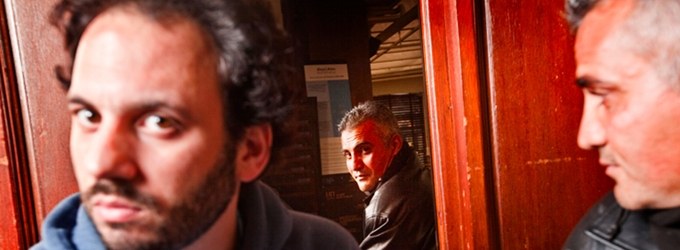 Filmed from the perspective of a Palestinian farm labourer (Emad Burnat), 5 BROKEN CAMERAS was shot using six different video cameras – five of which were destroyed in the process of filming. Charting the protests at Israeli plans to erect a wall through their land, our reviewer at CFF, Andrew Nickold declared it “an extraordinary piece of guerilla film-making”. Toby Miller, of Cambridge 105FM, got the opportunity to speak to co-director Guy Davidi.
Filmed from the perspective of a Palestinian farm labourer (Emad Burnat), 5 BROKEN CAMERAS was shot using six different video cameras – five of which were destroyed in the process of filming. Charting the protests at Israeli plans to erect a wall through their land, our reviewer at CFF, Andrew Nickold declared it “an extraordinary piece of guerilla film-making”. Toby Miller, of Cambridge 105FM, got the opportunity to speak to co-director Guy Davidi.
Toby Miller – To begin with, would you be able to tell me how you became involved with Emat Burnat’s film – and at what stage?
Guy Davidi – Originally I arrived in the village of Bil’in in 2005, just as their demonstrations were starting, and the same time that Emat started to film. My connection to the story was already build through the years I had spent there; I had made a few short films in the village, and my first feature documentary in that village; I had stayed and lived in the village during these productions, for three months almost. This is really rare because Israelis almost never go to the West Bank, and almost never go to live there for a while; even the activists are coming for one Friday demonstration, but not staying there. So this background knowledge helped me to develop a lot of ideas about the emotional consequences of living under occupation. And many of the film’s eventual voiceover text, as well as the philosophical and emotional ideas were, I think, built in that time. At the same time Emad did not think of doing a film, he didn’t know what documentaries really were at the beginning. So he was concentrating on doing film journalism work, catching material to give to news agencies, or television channels. He also taught himself to edit and some material he put up to YouTube as part of the activism. I knew film, I knew cameras, I was also teaching; we had things in common.
So in 2009 when Emat decided to make a film from his footage he approached me. There had been many films about the occupation, and and his first idea was to base his story around Adeeb and Phil, the two main characters. And the focus would be the death of Phil, and the film would commemorate his death, as well as tell the story of the non-violent movement. But when he approached me with this idea I refused, believing this was not good enough of an idea to make the documentary stand out. I also questioned the partnership between an Israeli and a Palestian – why do you need to do that? So I actually refused to begin with, but Emad convinced me to watch his footage. I then told myself that if we are going to do his film together, it’s only worth doing if Emad can bring out his personal story, as I knew what he had been through throughout the last few years.
I then told myself that if we are going to do his film together, it’s only worth doing if Emad can bring out his personal story, as I knew what he had been through throughout the last few years.
You would then have film about the three characters: Adeeb, who went to jail, Phil, who lost his life, and Emad, who is here to tell his story with his cameras. So that was the starting point. I also realised that a lot of the footage, whether or not it was of the demonstrations, could actually help support the film because everything is connected to him; it is his village, and people in the footage are his neighbours and his family, The strongest moment, when I knew that I wanted to be involved, was when I saw the image of this old man blocking the jeep from taking somebody to prison. Emad told me that was his father, and that he was blocking the jeep from taking one of his brothers to prison. For him the fact that it was personal was not something he bothered to mention because everything is personal so it makes it that nothing is personal. For me that was a starting point. And then we discovered all the footage he was filming throughout the years of his family without ever thinking this would be part of the documentary. So I had several roles in the production: Emad was the cameraman, but he didn’t know what kind of story to tell, he chose the characters – Adeeb and Phil – and he followed them. My main role was to tell the story, so I wrote the voiceover script, based around conversations we had had. Throughout those two years of structureing and editing the film – from 2009 to 2011 – Emad was still shooting footage, but this was more guided filming, as we now knew the shape of the film we were working towards. We had footage of the community demonstrations and footage of Emad’s personal story, but we didn’t have much footage that connected the two of them together. And so my role in that was to try and bring ideas of new scenes to film, but then letting Emad go and film them. These include the scene where Emad’s wife tells him to stop the filming, or when he takes his youngest son Gibreel to see a demonstration; all these scenes that connected the events outside with the events inside were taken under guidance that we had already built the story. So, in the end, the film was based on seven years of footage, rather than five.
The strongest moment, when I knew that I wanted to be involved, was when I saw the image of this old man blocking the jeep from taking somebody to prison.
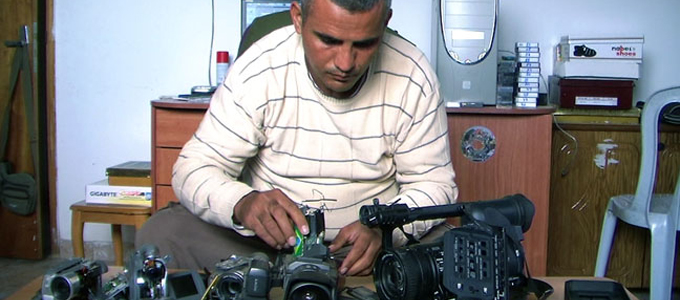
TM: There is a moment late in the film when the Israeli Defence Force (IDF) arrive in the middle of the night to arrest some teenaged boys, and we cut from that scene to Emad’s wife singing their youngest son Gibreel to sleep. That was the only moment when I felt the narrative seemed more planned than happenstance.
GD: Yes, of course those two events didn’t happen together, but there were many of those kinds of cuts on the film. Obviously Emad could not be in five places at once.
TM: How did you decide on the structuring of the film? The film’s publicity presents the Emad’s five broken cameras as the documentary’s only narrative hook are the cameras, but as you’ve already pointed out, there’s also the story of Phil and Adeeb, Emad’s two brothers and the growth to Gibreel, the son who is born at the start of the film. So there are lots and lots of threads running through the films, and it’s a very sophisticated piece of storytelling. Did this storytelling fall into place before or after the editing?
GD: This process was a simultaneous one; I started writing the text before the editing was begun, right at the beginning of the project, and then it was rewritten throughout the 2 years of actually editing the film. And the tone of the script…I didn’t want the film to be sentimental, and I didn’t want it to idealistic. For instance I don’t like people romanticising suffering, I don’t like people living with a sense of being victims, I don’t like films that allow us the wallow in the sense of suffering. So I tried to clean the text from all emotions that are banal and that we are familiar with. And also with accusations as well, a lot of films that deal with this subject, if they are showing pity towards the victims, they have an accusatory tone which I also wanted to avoid. We just really tried to avoid all the predictable emotional patterns a film like this usually has. We wanted to find the real sincere emotion that are happening here – and from that the text came out. But I think it is the content of the footage that determined the final tone – and then Emad came and read the voiceover, and the way he read it helped get across the feeling we were after.
I didn’t want the film to be sentimental, and I didn’t want it to idealistic. For instance I don’t like people romanticising suffering, I don’t like people living with a sense of being victims, I don’t like films that allow us the wallow in the sense of suffering.
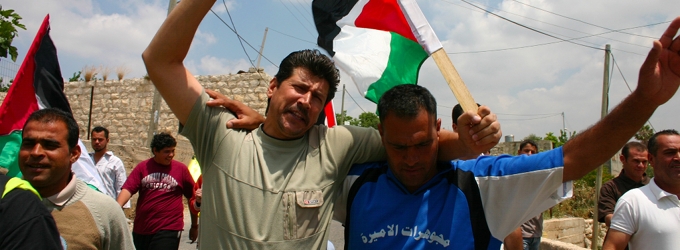
TM: and the actual editing….?
GD: The editing was started from scriptwriting really. I knew a few things that were important for me to tell. To start with the story is going to take place over a long period of time, and making sure there is a coherent chronology – a sense of time passing – was important. I was relieved when we realised that the birth of Gibreel, just a few days before the demonstrations began, as a very strong through line for the film. We have Gibreel born and we have the wall that is built and then we can follow the two together. And then the five broken cameras were worked into the edit quite early in the process. I remember as an activist that Emad was losing his camera, so when he told me he still had each of the five damaged cameras I thought that this is a great idea to help tell the story. So that’s another narrative that came out through chance really.
But the main challenge of the editing was how to make all the amounts of violence still emotional. Because you see one violent scene, it’s very strong, you see a second it’s still strong, you see a third time it is tiring and the fourth you want to leave the film. Actually violence is boring…and at the same time it was important to preserve this sense of repetition, which is crucial to understanding the occupation, because that’s what makes the story familiar. We all follow the situation on the West Bank and the repetitiveness of the story is part of how we know and indentify with it. For the villager the occupation is something you feel coming in waves, again and again and again. That was a motive in the film, even the music we chose, and the writing of the voiceover, all were designed to underline the repetitive nature of the struggle. And that was something that, for me, it was really important to sense in the film. But that is a challenge in the editing, to make it repetitive but not boring, and that is why we move from the intimate scenes to the external events. If you have an outside event that is happening, you don’t speak about it necessarily, you speak about something else that opens an personal or intimate sentiment, so you develop a tension between what is happening in his head as a characters, and what is happening outside, and that is what makes the film strong I think.
But that is a challenge in the editing, to make it repetitive but not boring, and that is why we move from the intimate scenes to the external events.
TM: When did you decide to never broaden the story out from that single village? There is a point about half way through the film when you overhear that the same situation with the encroaching settlement is going on I’m a neighbouring village. There is also the revelation, late on in the film, that there is court case processing to have the fence removed and the settlement pushed back. And you never give a wider context of the situation along the West Bank.
GD: My first decision was that if this is a personal film, told by Emad, then this sits in the gene of a POV film. It must remain committed to his POV and never go beyond it. That decision also protect me because I can then only write the voiceover from Emad’s perspective. If I tried to include something that he didn’t see, or didn’t agree with, then he would refuse to say it.
For instance, in the way he speaks about himself he can sometime still speak of himself as a victim, he still has the language of a victim, but in the reality of his actions he doesn’t live as a victim, he lives as a creator. So I chose to give him a language that illustrates much more his actual actions, then the way he speaks about them.
But also the footage never allowed us to stray from his POV. For instance, I really wanted to go into more detail about who makes up the Israeli settlers, because it is not as it appears. The occupants of the settlements are not religious fanatics, it is much, much more complicated than that. Actually the settlement in the film is a fairly moderate settlement and the people coming to live there are moving there not for ideological reasons, but for economical reasons. But all this I couldn’t explain because Emad couldn’t see this, because it is not his POV. He does not have the footage for that; he cannot go to the settlement to film…
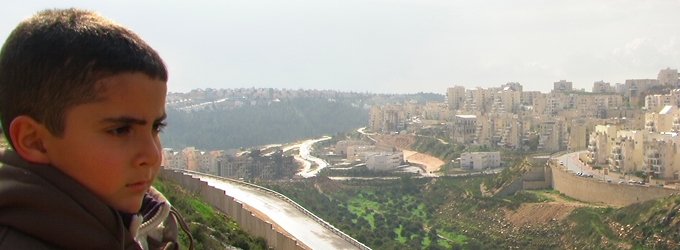
TM: …and because you only get a glimpse of the settlers, the rest of the film they are battling the IDF forces, who are always wearing masks, so they are basically fighting faceless soldiers. They might as well be STAR WARS villains. The approach this film takes, whist it allows a greatly shaded view of the village and the Palestinians, unfortunately also can’t prevent an almost Hollywood stereotype of the bad guy.
GD: That’s the expression of the separation. The separation means that when a Palestine experiences an Israeli they only experience them as soldiers in masks, with guns. The film has been criticised for being one sided, but of course it is one sided, it takes a point of view and it declares it. And actually I think it is much more honest when your saying that your film is told from a very clear point of view, you’re not trying to imitate an objective reality. Actually to have a wider context is impossible because there is no one wide context, there are many different wide contexts, so to deal with a wide context becomes much more paradoxical because your are trying to create an objectivity that you can never show. Our chosen POV is much more sincere and honest, so I’m actually very happy dealing with this subject in the way we have. Even if it simplifies the reality it gives you much more ability to show how we experience the day-to-day existence much more than a liberated journalistic work would be able to.
The film has been criticised for being one sided, but of course it is one sided, it takes a point of view and it declares it.
I also don’t like people trying to give criteria about the shape and form a documentary should take, criteria that says you must make sure you give a lot of information. But documentaries are about human experience, and human experience is not about information. I think in the western world there is a tendency to think that information is everything and experience is only something that is between the lines of the information, but that is not the reality. So I have to be committed to tell the experience, which is a spiritual one, and emotional one, it consists of many elements, and if I just reduce everything to information then I miss what humanity is all about.
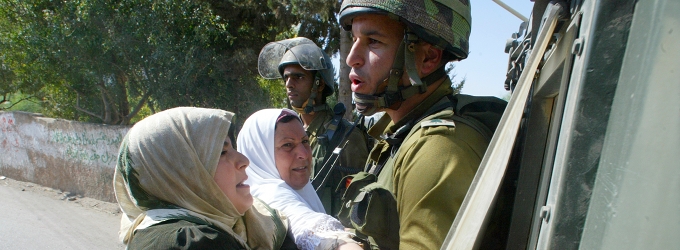
TM: For me one of the most interesting dialogue came was during the section after Emad is seriously injured. He crashes a tractor into the settlement fence, but in a simple accident, rather than an act of defiance, and is taken to hospital. He doesn’t get any compensation from the Palestine authorities because, as he says, he wasn’t injured in the cause.
GD: The film is not simply about putting the Palestine in the role of objecting and blocking occupation, life is much more than just that. And the film deals with other issues as well. One of those issues, which came from Emad himself, was to criticise the internal politics of the Palestian authority. It was important for him, because he saw a lot of hypocrisy. You have moments where this is made clear: the scene where the politicians are coming and showing themselves is meant as a direct criticism of Palestine, and then the second is the idealisms of the struggle, which means we don’t care about real suffering or real humanity issues, we care about who fits this model of resistance. Which is very problematic. Emad felt this because he was suddenly, after the accident, put into that position. Now his way was to try and prove that he was part of the resistance during that time, but as he told me, what happens to someone who has cancer or somebody who is ill? Why is it divided like that, why is there injustice like that?
TM: Everybody that I spoke to after the festival screening of the film, was devastated by the final screen. Even though the village has won it’s case, and the fence has been pushed back, you finish with the scene between Emad and the young Gibreel, who asks why his friend Phil was killed by the Israeli army. I personally found that this cut away the hope at the every end.
GD: I wanted this film to concentrate a lot of attention on the subject of anger and hate. And it’s not just showing how anger and hate are developed, the film is hopefully showing how the strong and inspiring human is struggling to create a positive thing from it. And I think it is the starting point of an inspirational movement, because we can idealise these non-violent movements, like we do in the west, but if we are blind to the challenge in it, then that is nothing. It is easy to walk around London in support of a non-violent demonstration, but it is not the same when people are dying around you, when there is a system that is infecting your emotions. I wanted the audience to go through that feeling that Palestinians have – and that will put them in a less judging and emotional atmosphere. And then, of course, the fragility of that choice is so important. We don’t know what Gibreel’s final choice will be. Will he grow up to be like his Father – and a lot of men in the village – by choosing non-violence and a response to the everyday experience of occupation, or that he’ll say “fuck” I don’t want to be part of the non-violent demonstration, I want to spread my anger. And Gibreel really is at the edge of that decision, because the suicide bombers, research shows the about 50% of suicide bombers in Israel were coming from children that lost their houses. Which is not surprising. So I think Gibreel suffered something so traumatic – but he is on the edge and that is something the film tried to catch, so it’s up to the audience to interpret what Gibreel may become in the future.
Thanks to Toby Miller for transcribing the interview, an edited version of which was broadcast on the Cambridge 105FM show Bums On Seats.

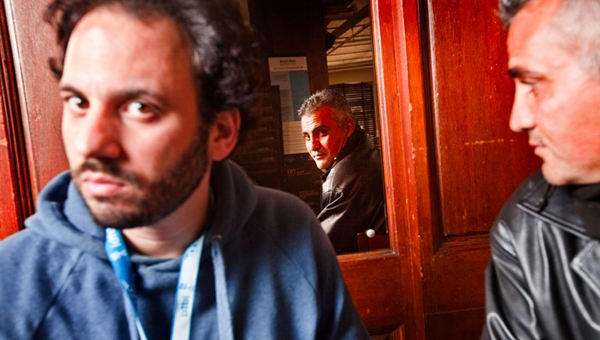
While viewing the video on Nov. 19, there were times I began to tear up. I had passed through the area in 1963, stopping in Aleppo, Damascus, Beirut, and E. Jerusalem, Amman and Petra as I drove from Helsinki to the Gulf of Aqaba and return. – William Savola, – Youtube